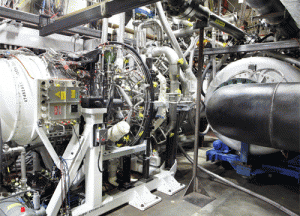The Hotter the Better
Make an engine that can run hotter and still survive, and you can get more thrust from the same amount of fuel
![]() Engineers who work in aviation learn to be risk averse. Change tends to happen slowly, through evolution rather than sudden breakthroughs. When a new idea comes along, it’s usually tested for years before being introduced to the fleet, and even then it usually debuts with the military—they have ejection seats, after all. Some engine components are tried out in ground-based turbines for electrical power plants before working their way into aircraft engines, a practice GE says it pursued for its latest engines.
Engineers who work in aviation learn to be risk averse. Change tends to happen slowly, through evolution rather than sudden breakthroughs. When a new idea comes along, it’s usually tested for years before being introduced to the fleet, and even then it usually debuts with the military—they have ejection seats, after all. Some engine components are tried out in ground-based turbines for electrical power plants before working their way into aircraft engines, a practice GE says it pursued for its latest engines.
One maxim of jet engine design is that higher power comes at a cost of greater heat. Unfortunately, heat melts metal. So anyone who can make an engine run hotter and still survive will be able to tweak more thrust out of the same amount of fuel. People have been working at the problem for years.
Early in the game, engineers tried alloys that could survive the 2,000+-degree-Fahrenheit gas that meets the first set of turbine blades. But the gas, coming straight from the combustor, put such stress on the turbines that they only lasted tens of hours. The metal would soften to a point where the rapidly spinning blades elongated, and their tips began to rub against the tip seals on the engine’s outer wall.
By combining metals such as nickel, chromium and even more exotic elements from the periodic table, engines could be made to run hotter and survive. Later, the blades were made from crystals grown in such a way that the metal’s grain aligned with the centrifugal force, lending greater strength. Another improvement was cooling the blades with tiny passages that carried cold air to the leading edge, using air from the engine’s compressor to supply the cooling flow. That stole some power from the compressor, but the investment paid off in higher combustion temperatures and improved power and efficiency.
Research into the use of ceramics in the engine’s hot section began decades ago, starting with ceramic coatings on combustors and parts of the turbine section. A NASA technical memorandum (89868) dated May 1987, authored by Gerald Knip, Jr. at NASA’s Lewis Research Center in Cleveland, Ohio, describes “revolutionary materials” applied to subsonic jet engines. It describes ceramic composites that overcome the typical brittle quality of ceramics by using reinforcing fibers in much the same way that carbon fiber reinforces modern composites.
GE and the Air Force are now going all in with advanced ceramics, which are incorporated into a research engine called ADVENT for ADaptive Versatile ENgine Technology. In tests, the engine is reported to have run hotter than any engine ever built. Ceramic matrix composites, or “CMCs,” made from silicon carbide matrix and fibers, make it possible for the engine to tolerate gas temperatures of 2,400 degrees and achieve a reported gain in fuel efficiency of 25 percent. With fuel prices so high, that kind of progress, following decades of materials research, couldn’t come at a better time.
